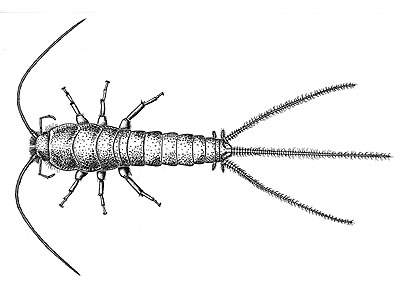
Order
THYSANURA(Greek, thysanos = fringe)
Common Names
silverfish, firebrats
Description
Silverfish are primitive, wingless insects covered with silvery scales that rub from the insect�s body very easily. The scales are the reason for the common name "silver"-"fish". Silverfish are small and flattened. Compound eyes are either reduced or absent. If eyes are present they are formed of single elements. One, two or three simple eyes (ocelli) may be present. Mandibles are present but may be covered by a 'beard' of hairs. Three abdominal filaments are present. Two, equal length appendages (cerci) arise from the sides of the second last abdominal segment. A third (median caudal appendage) arises from the middle of the last abdominal segment.
Silverfish may live for up to four years. Various species of silverfish are adapted to human dwellings, but others use caves or live under bark. Several species are commensals in ant or termite colonies. Firebrats are a group which have adapted to the high temperatures around ovens and fireplaces.
Silverfish resemble the species of another ancient and flightless insect Order, the Archaeognatha (bristletails). Bristletails differ in that they have well developed compound eyes and the middle tail bristle is much longer than the pair of side bristles. Silverfish are noctural insects i.e. they feed and are active at night.
Life Cycle
There is no metamorphic life cycle: egg-larva-pupa-adult. The juvenile (nymph) emerges from the egg as a replica of the adult and develops through moults. Eventually a final moult leaves it sexually mature.
Distribution
Members
Silverfish, firebrats.
Food
Bushland species, feed on lichens and fungi. In commensal situations, silverfish have been observed to "steal" nectar droplets from ants that are transferring regurgitated nectar from one to the other. Firebrats appear to feed on flour and similar materials. Household silverfish have been noted as attacking almost anything that contains food value: paper surfaces, starchy foodstuffs, silk, their own cast skins, other dead insects, cellulose materials (cotton, plant debris), etc.
Importance
Silverfish do not appear to have any importance in either agriculture or horticulture. Their significance seems to be limited to the nuisance effects or damage done to household or paper materials stored undisturbed for extended periods of time (e.g. archival books in libraries and museums). In bushland, silverfish undoubtedly play a role in litter re-cycling and food chains.